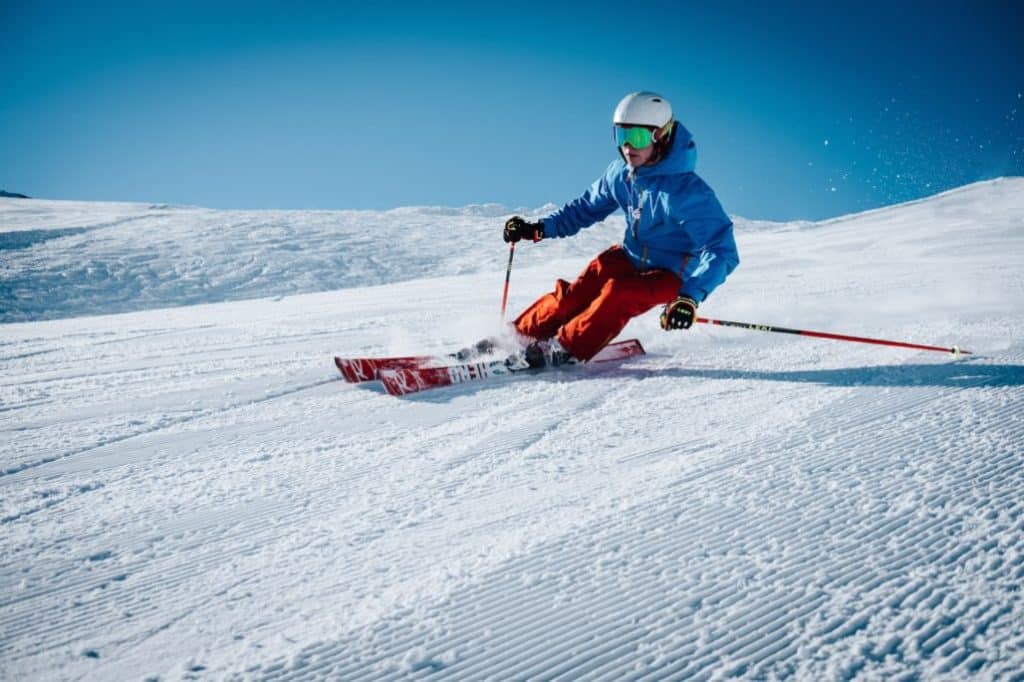Wondering what are the differences between parallel skiing vs carving? Both carving and parallel skiing are GREAT WAYS to make turns and have their own advantages and disadvantages, which we will explore in this post.
So, whether you’re a beginner looking to learn more about the different skiing techniques or an experienced skier wanting to find out which technique is better for you, keep reading!
Table of Contents
Difference Between Parallel Skiing and Carving
The main difference between carving and parallel skiing is that when you are carving you turn completely on your ski edges, whereas when you are parallel skiing your skis will be parallel to each other the whole time.
| Parallel Skiing | Carving |
| Slower | Faster |
| Basic technique | Advanced technique |
| Easier to learn | Difficult to learn |
| Skis stay parallel to each other. | Skis turn on edges. |
| Can be done on any slope | Cannot be done on any slope |
| Not as effective | More Efficient |
Let’s take a look at each of these techniques individually in greater detail.

Parallel Skiing
Parallel skiing or skidded turns is a basic skiing technique that all beginners should master (just like learning to stop on skis) so that they know how to make turns and avoid any obstacles ahead.
The most important step when parallel skiing is to keep your skis parallel to each other right from the start. You should start by keeping your feet at hip width and making sure it is not any wider as it will slow you down faster when you make the turns.
The more your feet and skis stay at hip-width, the more speed you will gain. This is the ultimate technique that you should be more attentive to when parallel skiing. However be careful not to bring your skis too close either because it will reduce the length between your knees and make it difficult to take turns.
Body balance is also important when making skidded turns but if you can keep your feet hip wide while skiing, you’ll be in a more comfortable position and the chances of falling down is low.
You also need to keep your upper body balanced and calm which plays a major role when you do turns. You must concentrate and try to keep your upper body perpendicular to the mountain which will help ski easily.
Why Do Skiers Make Parallel Turns?
The main reason skiers make parallel turns is to control the direction and avoid any obstacles on the slope, plus it helps maintain their speed. It also helps skiers maintain a stable posture and takes the pressure off their legs when slowing down.
Another reason why most beginner skiers make parallel turns is to get enough practice so that they could try more difficult turns like craving.
Pros and cons of Parallel Skiing
| Pros | Cons |
| Easier to learn | Slows you down |
| Much safer than most other techniques | Not as thrilling as the other turns |
| Can be done on any slope | Not always the ideal turn |
| Helps develop balance and confidence |
Carving
Most of us have seen those impressive skiers carving beautiful S-turns down the slopes and wondered how they make it look so easy.

The fact is, it isn’t easy and takes a lot of practice to master the technique just like learning to ski backwards. But once you get the hang of it, carving can be an extremely satisfying and fun way to ski.
When compared to parallel skiing, carving is a much more advanced and difficult technique plus it’s really eye-catching too. However if you can master skidded turns, you can learn to crave much faster.
Most modern skis are designed for craving and look like an hourglass with a rounded tip and a tail which make carving more comfortable.
Just like parallel skiing, keeping your feet at hip width is the first step to getting ready for craving. But when you get on the ski edges you should roll your knees over the skis or you will slip. Read more about how to carve here.
It is also very important to stay low and bend your knees when you are carving because it helps you make deeper cuts in the snow and gain a considerably higher speed.
Why Do Skiers Carve?
The main reason for craving instead of parallel skiing is to increase their speed and get to the bottom of the mountain faster. Plus it’s way more fun and exciting. Skiers also make carve turns in order to develop their turning skills so that they can enjoy a perfect ride down the slope.
Craving is regularly done in ski races. Almost all the skiers will be craving for maximum speed.
Pros and Cons of Craving
| Pros | Cons |
| Faster | Cannot be done on slope |
| More efficient | Need carving skis |
| No more sliding | Ski edges should be regularly sharpened |
| Difficult to learn |
Conclusion
Parallel skiing can be done on any slope and is easier and safer but slower, while carving is faster, more effective and difficult to learn.
Now that you know the main differences and the pros and cons of parallel skiing vs carving, you can decide which turn is right for you. If you’re a beginner, we recommend that you start with parallel skiing. Once you’ve mastered the basics, you can move on to carving.
Sharing is caring!


